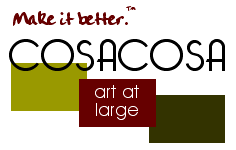



they can remind artists everywhere what the function of art has always been and will always be."
-Rudolph Arnheim
The dismissal of the social and therapeutic "aspects" of art can be an unnecessary defense against contamination by mass culture. Art therapy and revolutionary art can be practiced in ways that maintain the highest ideals of art history. If art therapy is to align itself with the history of art, it must demonstrate a sincere and intelligent treatment of the object together with a commitment to the making of significant art works...
Surrealism, like art therapy, is a philosophy and method of fully engaging art with life and psyche. Art becomes a ritual act that opens people to the experience of soul. The art object is a psychic tool rather than a commercial commodity, and the aesthetic contemplation of painting is encouraged as a way to experience "surreality"... As shamanic figures, the surrealist artists used their creativity to help others to participate in "surrealty." Like the shaman they took risks and used surprise, shock, and dramatic provocations to establish bonds with others. Their primary objective was the creation of a temenos where all could become immersed in a shared surreality. In art therapy, I have rarely encountered a group that was not capable of giving an intelligent and compassionate response to art. The audience has to be prepared for the event, however, and must fully accept its validity. If the audience in confused about the purpose of the event, if they are distrustful or uneasy, or it they have doubts about the relevance of the process, then the experience will not evoke a sense of safety and support that opens the heart and soul. The surrealists, like the shaman and the creative arts therapist, staged art experiences before audiences that understood and participated in their sacramental dimension.
This aspect of surrealism anticipated the role of the therapist as a witness and guide who participates in a shared art experience with others. The paintings and the persons are transformed through forces evoked by the audience and the surrounding environment. People present themselves and their work in order to experience the transformative effects of a rite de passage. A person might present a simple stone or household artifact that initially arouses little interest. But as the objects are used in performances, or after the owner tells a story about how they embody significant events and passages, they are "ensouled" and alive for everyone in the group. The objects are animated by the attention they receive.
People looking at the object to not "give" soul to it. They witness and affirm the soul qualities that are already present but unseen. The same applies to persons. The group affirms the life of the soul that is active in all of us but which goes unseen and unacknowledged...
In art therapy we see how the environment of the studio is transformed when people begin to interact creatively with their pictures. When this shift occurs, the feeling tone immediately changes, imagination enters the room, and an unconscious sense of sacred spectacle, safety, and support from others is established...
Many of us in art therapy are refugees and immigrants from art's elitist and self-serving values, which have not provided access to the depths of the psyche since the revolutionary days of the surrealists. Art therapy, like surrealism, focuses on using the creative process to treat and attend to the other, thriving on collaborations with other disciplines. Art as medicine reveals how the interaction of painting and pyschotherapy deepens both...
The commercial art world is allied with a particular set of economic values, and we make an error when we perceive this context to be the exclusive or the highest realm of art. For those of us in art therapy who desire to participate as full citizens in the community of art and its history, the revival of surrealist principles may offer access. If we want art history's attention, we have to speak its language and acknowledge its traditions. Art as medicine, like surrealism, is a manifestation of art's desire to connect psyche, the dream, the suffering soul, and the daily lives of other people.
Shaun McNiff, Ph.D., is a professor and founder of graduate programs bringing the arts to psychotherapy and education. He is the author of numerous books on art and healing, including Art as Medicine, from which this essay is excerpted.